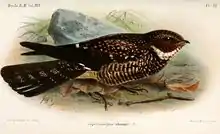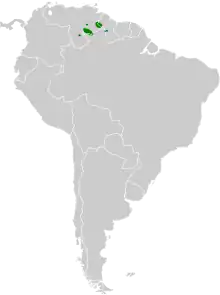Roraiman nightjar
The Roraiman nightjar (Setopagis whitelyi) is a species of nightjar in the family Caprimulgidae. It is found in Brazil, Guyana, and Venezuela.[2]
| Roraiman nightjar | |
|---|---|
 | |
| Illustration by Keulemans, 1892 | |
| Scientific classification | |
| Domain: | Eukaryota |
| Kingdom: | Animalia |
| Phylum: | Chordata |
| Clade: | Dinosauria |
| Class: | Aves |
| Clade: | Strisores |
| Order: | Caprimulgiformes |
| Family: | Caprimulgidae |
| Genus: | Setopagis |
| Species: | S. whitelyi |
| Binomial name | |
| Setopagis whitelyi (Salvin, 1885) | |
 | |
| Synonyms | |
| |
Taxonomy and systematics
The Roraiman nightjar was described as Anstrotomus whitelyi and was later lumped into genus Caprimulgus. Since the early 2010s has been placed in its current genus Setopagis. It is monotypic.[3][4][2]
Description
The Roraiman nightjar is 21 to 22.4 cm (8.3 to 8.8 in) long. Males weigh 30 to 40 g (1.1 to 1.4 oz) and females 45 to 48 g (1.6 to 1.7 oz). The male's upperparts are blackish brown with cinnamon and grayish spots. The tail feathers are dark brown; the outermost three pairs have faint but broad pale buff bars and two pairs have large white spots at their tips. The wings are mostly dark brown with a thin white bar near the end and white spots near the body. The chin and upper throat are dark brown, the lower throat white, the breast dark brown with pale buff bars, and the belly and flanks pale buff with brown bars. The female is more brownish than blackish, the wing spots and bars are smaller and buffy instead of white, and the white spots on the tail are smaller.[4]
Distribution and habitat
The Roraiman nightjar is found in the tepui region at the junction of southeastern Venezuela, southwestern Guyana, and northernmost Brazil. It inhabits open areas such as savanna, clearings, and the edges of forest. In elevation it ranges between 1,280 and 1,800 m (4,200 and 5,900 ft) in Venezuela but has been recorded as low as 850 m (2,790 ft) in Guyana.[4]
Behavior
Feeding
The Roraiman nightjar is nocturnal. Little is known about its foraging behavior, whether it forages by sallying from the ground or a low perch and/or during continuous flight.[4]
Breeding
The Roraiman nightjar's breeding phenology is unknown. It is assumed to lay one or two eggs directly on the ground like other nightjars.[4]
Vocalization
The Roraiman nightjar's song is "a burry hreeer, rising then falling in pitch, and repeated at intervals of 1-2 seconds."[4]
Status
The IUCN has assessed the Roraiman nightjar as being of Least Concern. Though its population is unknown it is believed to be stable. The primary threat is habitat modification; the tepui vegetation when damaged does not regrow but is replaced by vegetation less suitable for the nightjar.[1]
References
- BirdLife International (2016). "Roraiman Nightjar Setopagis whitelyi". IUCN Red List of Threatened Species. 2016. Retrieved 8 October 2021.
- Gill, F.; Donsker, D.; Rasmussen, P. (July 2021). "IOC World Bird List (v 11.2)". Retrieved July 14, 2021.
- Remsen, J. V., Jr., J. I. Areta, E. Bonaccorso, S. Claramunt, A. Jaramillo, D. F. Lane, J. F. Pacheco, M. B. Robbins, F. G. Stiles, and K. J. Zimmer. Version 24 August 2021. A classification of the bird species of South America. American Ornithological Society. https://www.museum.lsu.edu/~Remsen/SACCBaseline.htm retrieved August 24, 2021
- West, M. and T. S. Schulenberg (2020). Roraiman Nightjar (Setopagis whitelyi), version 1.0. In Birds of the World (T. S. Schulenberg, Editor). Cornell Lab of Ornithology, Ithaca, NY, USA. https://doi.org/10.2173/bow.rornig1.01 retrieved October 8, 2021
